-
StuffStuff of stuff
-
Intuaura PurpleFlagship of the Intuaura brand, featuring a single DD that is well tuned
-
Acoustune HS1790TI Universal In Ear Monitor"The second generation Myrinx Composite driver is a dynamic driver with a composite membrane...
-
Tangzu x HBB Xuan NVTangzu and HBB's second collaboration featuring 2DDs, a resin shell and is priced at $70
-
CCZ BC04CCZ BC04 A new upgrade 10MM CNTD dynamic driver was developed. Carbon nanotubes are...
-
Penon VoltageTribrid IEM from Penon 2X8mm dynamic+4X Sonion BA+4X Sonion EST
-
Lavricable Master Silver V4Master Silver AWG22 2 pin upgrade cables from Lacricable
-
TANSIO MIRAI FeatAll Resin Dual 8mm Coaxial DD + 2 Knowles BA Hybrid
-
Tansio Mirai XTSMR-X 10th anniversary edition hybrid IEMs
-
Simgot LC7 IEM cableSimgots first IEM cable.
You are using an out of date browser. It may not display this or other websites correctly.
You should upgrade or use an alternative browser.
You should upgrade or use an alternative browser.
Semkarch CNT1
- Added by Dsnuts
- Create date
Latest reviews
FastAndClean
Previously known as presata
Pros: snappy bass response, once corrected with EQ it is very powerful and deep with great control, good isolation, non fatiguing treble, warm midrange, good imaging
Cons: stock cable needs replacement, midrange lack dynamic range, the treble is good but is a bit grainy sounding, the sub bass is lower in level compared to the mid bass, needs EQ to really shine

source for the review - Sabaj DA3 (from the balanced out)
Songs used for the review
Coltsblood - Return To The Lake Of Madness
Belzebong - Sonic Scapes & Weedy Grooves (album)
Boards Of Canada - Kid For Today
Squarepusher - Ultravisitor
Squarepusher - Tundra4
Squarepusher - Plotinus
Photek - Modus Operandi
Nocow - Mist
Yosi Horikawa - Wandering
Yosi Horikawa - Interlude
Hans Zimmer - Why do we fall
Hans Zimmer - Gotham's Reckoning
Macc & dgoHn - Long Tall Sally
Audiomachine - Forgive Us Our Trespasses
Bassnectar - Timestretch
Marcin Przybylowicz - Mystery Man
Bat For Lashes - Rest Your Head
Wydron - Third Gate
Balkansky - Sundown
Paradox - A Funky Mule
Jim Keltner - Improvisation
Eric Clapton - My father's Eyes
Nah Youn Sun - My Favorite Things
Inception - Dream Collapsing
Steve Strauss - Youngstown
Stimulus Timbre - Expression
The DALI CD - Zhao Cong , Moonlight on Spring River
Rebecca Pidgeon - Grandmother
Hans Zimmer - Dream Is Collapsing
Hans Zimmer - Molossus
Harry Gregson - Emergency Launch
Shpongle - Shpongle Spores
Dizzy Gillespie - Could it Be You
Dominik Eulberg - Bjorn Borkenkafer
Trentemoller - The Forest
Kryptic Minds And Leon Switch - Ocean Blue
Jed Palmer - Upgrade (2018)(Album)
Plug_-_Drum_'N'_Bass_For_Papa-2CD-1997-FLAC(Album)
Jon Hopkins - Insides (2009)(Album)Eric Serra - Lucy (2014) [flac](Album)
specs
- Driver: CNT Dynamic driver
- Sensivity:108±1Db
- Impedance:32ohm
- Frequency range:10Hz-26000Hz
- THD: <0.2%
- Rated power:5mW
- Plug:3.5mm gold-plated
- Cable length:120cm
- Black filters : 3khz-10khz+2db
- Gold filters : 3khz-10khz-2db
I needed something similar to my speaker setup because i was living in apartment at that time and there was some complains from the neighbors about the bass traveling through the walls.
I was reading in the basshead thread and there was one recommendation that i was able to find for good price at that time - M Audio Studiophile Q40.
The requirement for that headphone to have powerful bass and good comfort at the same time was simple, just change the pads and ad bass EQ, as much as you want.
When i got the CNT1 the first impression was not positive, so i changed the black filter with the gold one and let them play. To my surprise after a couple of hours the first thing that i though was - "that is Q40 in IEM form"
Build, fit and comfort
They are made from metal, the build is solid but some reports of bad QC units exist.
it was hard for me to get a good fit with the stock tips, the gray tips from one of my Blon BL03 units did the job just fine
the cable is stiff and unusable for me, i use 16 core balanced cable
Isolation
the isolation is very good, surprising and unexpected
Overall sound signature.
they sound like a U shaped to me, but the dip in the mids is in the upper part
the bass part i will give impressions without and with EQ
Bass
(without EQ)
The bass stock without corrections is mid bass boosted, the sub bass is there but lower in level compared to the mid bass. The bass after burn in have impressive control and speed, on my source it is very tight and quick, the driver is very well damped but is not suffering from bad dynamic range, it has good dynamics but is a bit lacking in the sub bass department (similar to the Q40 uncorrected). I was very curious if it will retain the control and dynamics when EQd.
(with EQ correction)

That is basically my EQ correction, lowering the mid bass and boosting the sub bass.
With that the sub bass is significantly more and lowering the mid bass gives the bass tonality much cleaner profile.
The bass impact is dramatic and very dynamic, it jumps at you with the right song retaining the amazing control and tightness, with high volume listening with heavy music like Doom metal the kick drums are snappy and punchy, the rumble is quick and powerful with very good texture. Overall the bass is amazing to me, very enjoyable and fun.
Mids
The midrange is one step back in the whole signature but only the upper mids, mid and lower midrange is there so the tonality is somewhat warm and full but not overly so. For vocal music they are good but not very good.
The midrange sound like is a little bit constricted, the dynamic range is not very good in that area and is not very open. The tonality is very good but is a bit compressed sounding. They are not my choice for Amber Rubarth.
Treble
The treble response have some sparkle in the mid treble, before that there is a dip, after the mid treble is starting to roll of.The extension is average, the detail retrieval is good but the tonality of the treble is with a bit of grain to it.
The treble is not particularly smooth, they are not harsh or sibilant but the tone has a bit of sizzle.
Not the most refined treble but it is good overall.
Soundstage and imaging.
the soundstage size is average, nothing special here, the imaging i find to be very good, it has good positioning and the drivers are able to keep everything under control even on high volume listening
Conclusion
Bass is the reason why i like them so much, that is the reason for the high rating
For critical listening they are not my first choice but for electronic music they are
for the original price of 95$ they are good, for under 50$ i will recommend them for sure
especially if you like to play with EQ a bit and enjoy snappy powerful bass response
Have a good one.

baskingshark
Headphoneus Supremus
Pros: Two tuning filters to make sound signature more balanced or pseudo basshead
Good timbre/tonality
Cheap at current fire sale pricing
Non fatiguing
Above average accessories
Above average isolation, clarity, details, instrument separation
Easy to drive but scales better with DAC/AMP
Good all rounder for most genres
Good timbre/tonality
Cheap at current fire sale pricing
Non fatiguing
Above average accessories
Above average isolation, clarity, details, instrument separation
Easy to drive but scales better with DAC/AMP
Good all rounder for most genres
Cons: Questionable build quality, driver flex
Very microphonic and stiff stock cable
Average soundstage
May not be able to separate instruments as well as some multi BA/hybrid sets
Recessed midrange (especially for upper midrange)
No more in production, so might be difficult to find a set
Very microphonic and stiff stock cable
Average soundstage
May not be able to separate instruments as well as some multi BA/hybrid sets
Recessed midrange (especially for upper midrange)
No more in production, so might be difficult to find a set
Disclaimer #1:
I bought the CNT1 from Ebay at my own expense.
Disclaimer #2:
The product insert for the CNT1 recommends 100 - 200 hours burn in. I thought the CNT1 sounded good out of the box, but nevertheless I have burnt it in for about 50 hours currently via listening. I honestly didn't hear much of a difference between the 0 hour mark and the 50 hours mark, but I will post any updates here if there are any changes subsequently beyond 100 hours.
Introduction:
The SKC CNT1 has been around for some time and had generally good reviews and a cult following. It was previously retailing at $95ish USD, but recently production has stopped and there was a fire sale of sorts on Aliexpress, Taobao and Ebay, with sets going as low as $28 - 35 USD. As of the time of writing this review, there are still some sets available on Aliexpress, Taobao, Ebay and Amazon.
I hesitated to get the CNT1 initially as I already had 2 single DD IEMs in the Toneking Ninetails and TFZ No.3, but I couldn't resist giving it a try at the fire sale prices.
At the time of writing, the current flavour of the month for CHIFI single DD IEMs is still the BLON BL-03 though, and I'm awaiting my set, but will post updates and comparisons here soon.
Specifications:
- Driver: CNT Dynamic driver
- Sensitivity: 108dB
- Cable: MMCX detachable cable
- Frequency response: 10Hz - 26kHz
- Impedence: 32Ω
Accessories:
In addition to the IEM, it comes with:
- Soft case
- Detachable 3.5 mm stock cable - very stiff and microphonic, I would say it is even worse than the usual budget KZ cables. I had to swap it out within a few minutes of use due to the microphonics.
- Multiple silicone tips
- Black and gold filters
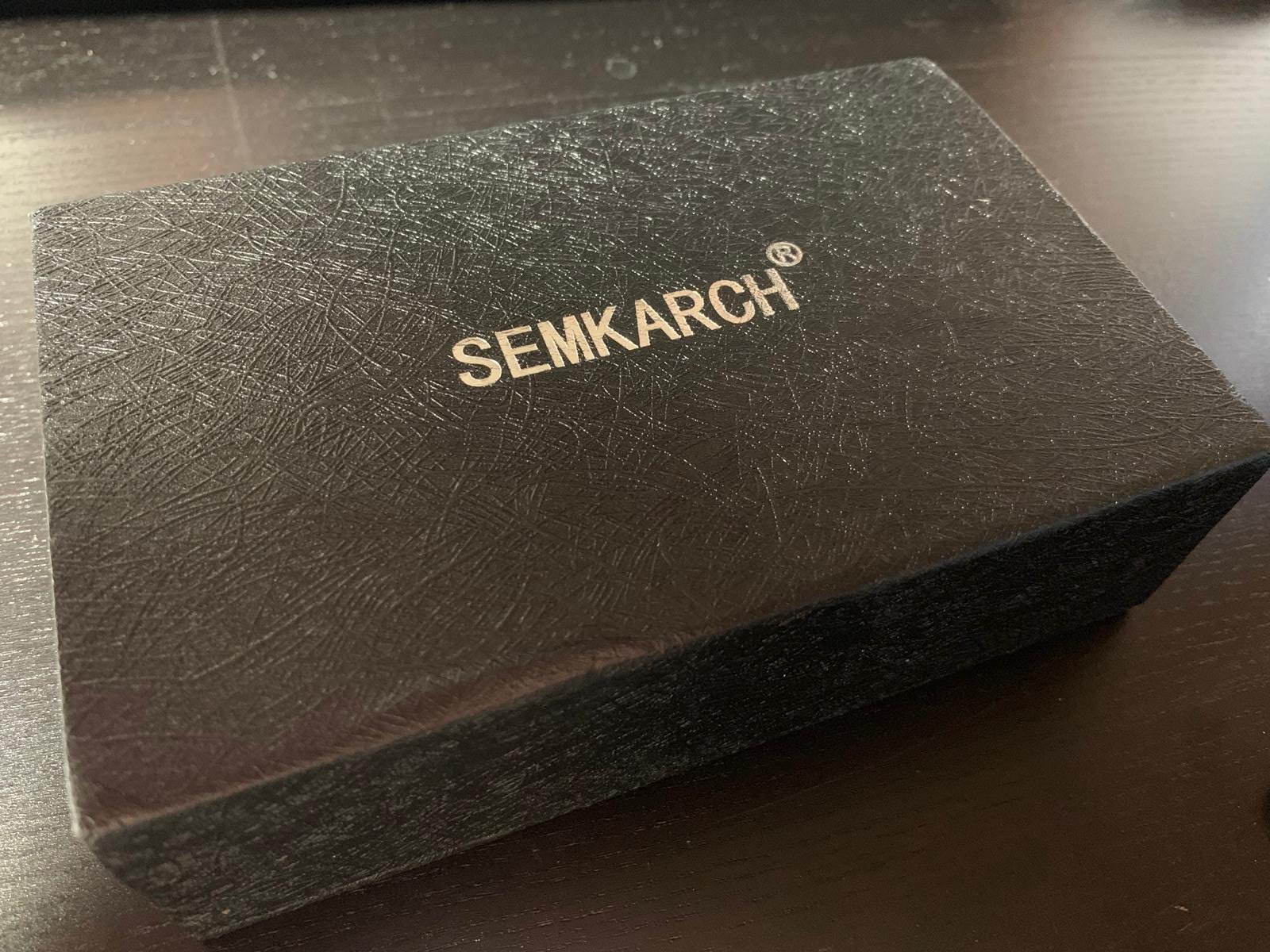
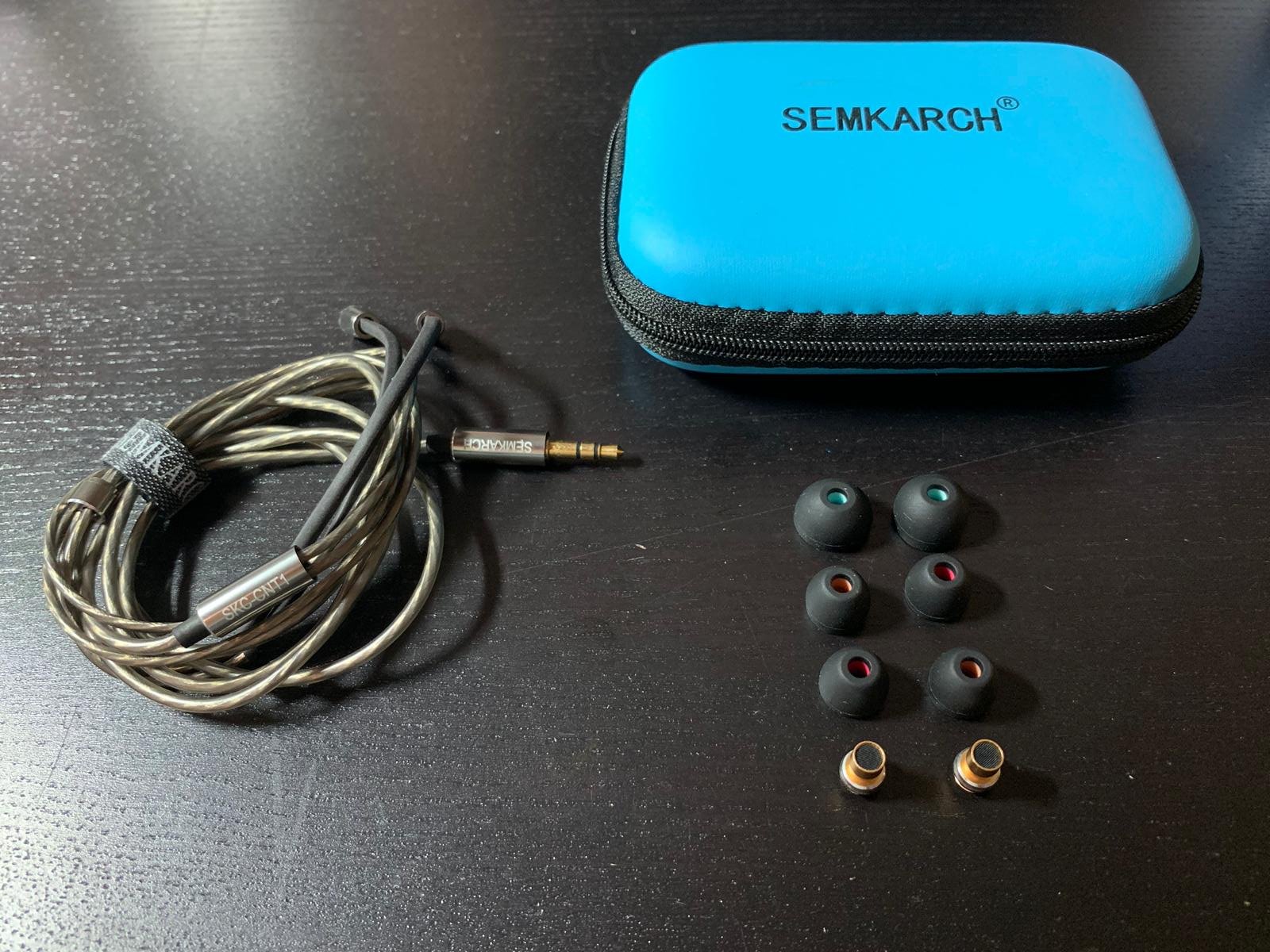
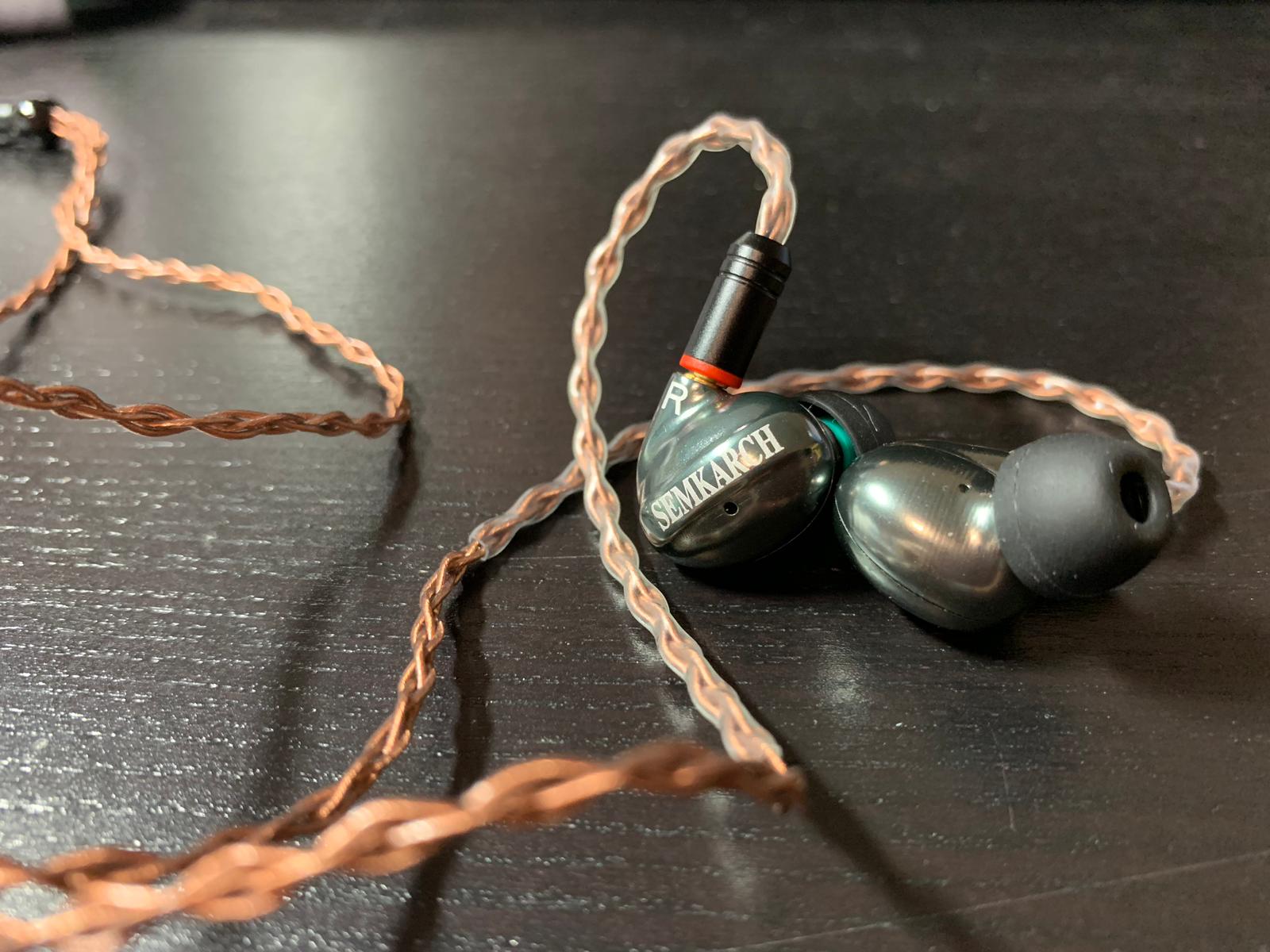
The SKC CNT1 seen here with after market copper cables, as the stock cables were a no go for me due to the microphonics and stiffness.
Build/comfort:
The build is questionable in terms of QC. One side of the MMCX connector was extremely tight and I had difficulty connecting and removing various cables to that side. The seam in the middle of the IEM shell also makes it look a bit shabby. I read an account on headfi that one user's CNT1 shell fell apart at the seams too.
Otherwise the IEM is actually very small, ergonomic, comfortable and light. I can wear it for hours without issues. In fact I have fallen asleep with it in my ears on a few occasions.
I had some driver flex during insertion of the IEMs.
Isolation:
Above average compared to my other CHIFIs. I have tested it on the subway and buses and it manages to block out most noise once music is playing, though some subbass may be lost due to the incomplete isolation on the go.
Filters:
The filters do work and ain't gimicks.
a) Black filters - boosts the bass. My favourite filter as I'm a basshead but I would say it is just one level shy of true basshead levels.
b) Gold filters - makes the bass less pronounced, but does increase the treble and overall gives it a more neutralish tuning.
Sound:
I tested this with a Desktop -> Khadas Tone Board -> Fiio A3 and Ziku HK-X9. The CNT1 is quite easily drivable from smart phones but definitely scales better with a DAC/AMP. I didn't have any hiss with this IEM on laptops/PC/smartphones.
After tiprolling, I still found the stock tips to be the most suitable for me for isolation and comfort. I tested most of the 50 hours with the black filters on, so most of my impressions here are based on the black filter.
The CNT1 has a V shaped tuning, with recessed mids. I found the clarity and details to be good for a single DD driver, but it won't trump a dedicated multi BA/hybrid IEM in this aspect. Instrument separation is above average. I would say the CNT1 is quite an all rounder and suitable for most musical genres.
Bass:
As above, you can fine tune the bass quantity with filters, and with the black filters on, it is very typical of a well tuned DD driver, with good subbass extension and displacement of air. Bass is punchy and fast for a DD bass and hits hard in the midbass. Subbass has a slight roll off compared to midbass. It has good timbre and quantity and quality, but is just a level or two shy of jaw rattling basshead levels. I noted that in some songs with very complex bass movements, it generally managed to keep up. I didn't notice any midbass bleed.
Mids:
Quite recessed, typical of the V shaped tuning. Note weight/density is quite good. The lower mids are more forward than higher mids, hence male voices sound more forward than female ones. Nevertheless, the mids are detailed with good clarity and instrument separation. The timbre of voices and instruments from the CNT1 is very good, as typical of other dedicated DD IEMs, but may lose out a bit in this area to the Toneking Ninetails, which is my gold standard for timbre currently.
Treble:
Treble has no fatigue/harshness/sibilance. Very good for listening for long sessions and having a relaxing listen. I would class it on the slightly darker side compared to the usual bright CHIFI treble tuning, especially at the higher frequencies where there is a roll off. The lower treble is slightly boosted but not harsh. I didn't notice any peaks or spikes, and neither did I notice any grain on the treble.
Soundstage:
Average compared to my other CHIFI IEMs.
Comparisons:
As detailed above, the CNT1 won't beat most multi BA/hybrids in the clarity and details segment by virtue of it being a single DD IEM. So I have compared it to my 2 other single DD IEMs that I currently own:
a) TFZ No. 3
The clarity and details is a tinge better on TFZ No.3.
Instrument separation and imaging is better on TFZ No. 3.
Treble is brighter on the No. 3 especially the lower treble and 8kHZ area, which is not present in the CNT1. There is a roll off at higher frequencies for both of these IEMs.
Lower mids are more forward on the CNT1 compared to the TFZ No. 3, whereas higher mids are more forward on the TFZ No. 3.
The TFZ No. 3 bass and subbass extends deeper and has more oomph and displaces more air than the CNT1. The bass decay is longer on the TFZ No. 3 and it has a mild midbass bleed compared to the CNT1 (some people may not like it, but I like the midbass bleed for greater warmth in the lower mids). I would say the TFZ No. 3 has better bass quantity and quality compared to the CNT1.
Soundstage is better on the TFZ No. 3.
Isolation and timbre both are on par.
b) Toneking Ninetails
As the Ninetails has 9 customizable tuning filters, I have compared the CNT1 (on black filters for bassy sound) to the Ninetails with the red and silver combination filters (which gives it a more bassy sound signature):
The clarity and details is slightly better on Ninetails.
Instrument separation is better on Ninetails.
The treble on both are non fatiguing but maybe the CNT1 has slightly brighter highs.
The mids are equally recessed on both.
The bass is slightly muddier on the Ninetails (which has a longer decay), but otherwise they hit equally hard in the bass.
Timbre is more natural and organic on the Ninetails.
Soundstage much wider on Ninetails, but isolation worse on Ninetails.
I would consider the Ninetails and TFZ No. 3 to be sidegrades over the CNT1, with marginal improvements in areas like soundstage, clarity, instrument separation, details, but they are currently 2 - 3 times more expensive, so whether one would pay the extra dough for these slight upgrades is subjective.
Conclusion:
At the CNT1's original pricing of $95 USD, I would have hesistated to recommend it over other single DD IEMs around that pricing like the Toneking Ninetails or TFZ No. 3, but at the current fire sale price, it is good for price to performance ratio. It has 2 customizable sound signatures and I think bassheads like myself would like the kick it gives with the black filters. It is a great all rounder for most music genres, and has above average clarity/details/instrument separation (not comparing it with dedicated multi BA/hybrids of course). Tonality and timbre is very good. It is comfortable and non fatiguing and a great CHIFI addition for those looking for a cheap and good single DD IEM.
Get it while you can, since it is no longer in production (which is a pity).
Do get a better aftermarket cable, and we are all good to go.
I bought the CNT1 from Ebay at my own expense.
Disclaimer #2:
The product insert for the CNT1 recommends 100 - 200 hours burn in. I thought the CNT1 sounded good out of the box, but nevertheless I have burnt it in for about 50 hours currently via listening. I honestly didn't hear much of a difference between the 0 hour mark and the 50 hours mark, but I will post any updates here if there are any changes subsequently beyond 100 hours.
Introduction:
The SKC CNT1 has been around for some time and had generally good reviews and a cult following. It was previously retailing at $95ish USD, but recently production has stopped and there was a fire sale of sorts on Aliexpress, Taobao and Ebay, with sets going as low as $28 - 35 USD. As of the time of writing this review, there are still some sets available on Aliexpress, Taobao, Ebay and Amazon.
I hesitated to get the CNT1 initially as I already had 2 single DD IEMs in the Toneking Ninetails and TFZ No.3, but I couldn't resist giving it a try at the fire sale prices.
At the time of writing, the current flavour of the month for CHIFI single DD IEMs is still the BLON BL-03 though, and I'm awaiting my set, but will post updates and comparisons here soon.
Specifications:
- Driver: CNT Dynamic driver
- Sensitivity: 108dB
- Cable: MMCX detachable cable
- Frequency response: 10Hz - 26kHz
- Impedence: 32Ω
Accessories:
In addition to the IEM, it comes with:
- Soft case
- Detachable 3.5 mm stock cable - very stiff and microphonic, I would say it is even worse than the usual budget KZ cables. I had to swap it out within a few minutes of use due to the microphonics.
- Multiple silicone tips
- Black and gold filters



The SKC CNT1 seen here with after market copper cables, as the stock cables were a no go for me due to the microphonics and stiffness.
Build/comfort:
The build is questionable in terms of QC. One side of the MMCX connector was extremely tight and I had difficulty connecting and removing various cables to that side. The seam in the middle of the IEM shell also makes it look a bit shabby. I read an account on headfi that one user's CNT1 shell fell apart at the seams too.
Otherwise the IEM is actually very small, ergonomic, comfortable and light. I can wear it for hours without issues. In fact I have fallen asleep with it in my ears on a few occasions.
I had some driver flex during insertion of the IEMs.
Isolation:
Above average compared to my other CHIFIs. I have tested it on the subway and buses and it manages to block out most noise once music is playing, though some subbass may be lost due to the incomplete isolation on the go.
Filters:
The filters do work and ain't gimicks.
a) Black filters - boosts the bass. My favourite filter as I'm a basshead but I would say it is just one level shy of true basshead levels.
b) Gold filters - makes the bass less pronounced, but does increase the treble and overall gives it a more neutralish tuning.
Sound:
I tested this with a Desktop -> Khadas Tone Board -> Fiio A3 and Ziku HK-X9. The CNT1 is quite easily drivable from smart phones but definitely scales better with a DAC/AMP. I didn't have any hiss with this IEM on laptops/PC/smartphones.
After tiprolling, I still found the stock tips to be the most suitable for me for isolation and comfort. I tested most of the 50 hours with the black filters on, so most of my impressions here are based on the black filter.
The CNT1 has a V shaped tuning, with recessed mids. I found the clarity and details to be good for a single DD driver, but it won't trump a dedicated multi BA/hybrid IEM in this aspect. Instrument separation is above average. I would say the CNT1 is quite an all rounder and suitable for most musical genres.
Bass:
As above, you can fine tune the bass quantity with filters, and with the black filters on, it is very typical of a well tuned DD driver, with good subbass extension and displacement of air. Bass is punchy and fast for a DD bass and hits hard in the midbass. Subbass has a slight roll off compared to midbass. It has good timbre and quantity and quality, but is just a level or two shy of jaw rattling basshead levels. I noted that in some songs with very complex bass movements, it generally managed to keep up. I didn't notice any midbass bleed.
Mids:
Quite recessed, typical of the V shaped tuning. Note weight/density is quite good. The lower mids are more forward than higher mids, hence male voices sound more forward than female ones. Nevertheless, the mids are detailed with good clarity and instrument separation. The timbre of voices and instruments from the CNT1 is very good, as typical of other dedicated DD IEMs, but may lose out a bit in this area to the Toneking Ninetails, which is my gold standard for timbre currently.
Treble:
Treble has no fatigue/harshness/sibilance. Very good for listening for long sessions and having a relaxing listen. I would class it on the slightly darker side compared to the usual bright CHIFI treble tuning, especially at the higher frequencies where there is a roll off. The lower treble is slightly boosted but not harsh. I didn't notice any peaks or spikes, and neither did I notice any grain on the treble.
Soundstage:
Average compared to my other CHIFI IEMs.
Comparisons:
As detailed above, the CNT1 won't beat most multi BA/hybrids in the clarity and details segment by virtue of it being a single DD IEM. So I have compared it to my 2 other single DD IEMs that I currently own:
a) TFZ No. 3
The clarity and details is a tinge better on TFZ No.3.
Instrument separation and imaging is better on TFZ No. 3.
Treble is brighter on the No. 3 especially the lower treble and 8kHZ area, which is not present in the CNT1. There is a roll off at higher frequencies for both of these IEMs.
Lower mids are more forward on the CNT1 compared to the TFZ No. 3, whereas higher mids are more forward on the TFZ No. 3.
The TFZ No. 3 bass and subbass extends deeper and has more oomph and displaces more air than the CNT1. The bass decay is longer on the TFZ No. 3 and it has a mild midbass bleed compared to the CNT1 (some people may not like it, but I like the midbass bleed for greater warmth in the lower mids). I would say the TFZ No. 3 has better bass quantity and quality compared to the CNT1.
Soundstage is better on the TFZ No. 3.
Isolation and timbre both are on par.
b) Toneking Ninetails
As the Ninetails has 9 customizable tuning filters, I have compared the CNT1 (on black filters for bassy sound) to the Ninetails with the red and silver combination filters (which gives it a more bassy sound signature):
The clarity and details is slightly better on Ninetails.
Instrument separation is better on Ninetails.
The treble on both are non fatiguing but maybe the CNT1 has slightly brighter highs.
The mids are equally recessed on both.
The bass is slightly muddier on the Ninetails (which has a longer decay), but otherwise they hit equally hard in the bass.
Timbre is more natural and organic on the Ninetails.
Soundstage much wider on Ninetails, but isolation worse on Ninetails.
I would consider the Ninetails and TFZ No. 3 to be sidegrades over the CNT1, with marginal improvements in areas like soundstage, clarity, instrument separation, details, but they are currently 2 - 3 times more expensive, so whether one would pay the extra dough for these slight upgrades is subjective.
Conclusion:
At the CNT1's original pricing of $95 USD, I would have hesistated to recommend it over other single DD IEMs around that pricing like the Toneking Ninetails or TFZ No. 3, but at the current fire sale price, it is good for price to performance ratio. It has 2 customizable sound signatures and I think bassheads like myself would like the kick it gives with the black filters. It is a great all rounder for most music genres, and has above average clarity/details/instrument separation (not comparing it with dedicated multi BA/hybrids of course). Tonality and timbre is very good. It is comfortable and non fatiguing and a great CHIFI addition for those looking for a cheap and good single DD IEM.
Get it while you can, since it is no longer in production (which is a pity).
Do get a better aftermarket cable, and we are all good to go.
Last edited:
S
ShakeThoseCans
Yes. I'll be careful with the high-end multi-BA/hybrid purchase, gonna buy a V90 for the interim. I'm also still interested in nicely-tuned bass-friendly single-DDs like the IT-01 and No. 3, if I can get them at a discount, because the CNT-1 has shown me the general concept is sound. I would appreciate the slightly greater soundstage, instrument separation, and detail present in the IT-01/No. 3/Ninetails. Too bad about the Ninetails' isolation, though.
baskingshark
I haven't heard the IT01, but No. 3's soundstage isn't much wider than the CNT1 though. I have seen it go around 85ish USD during discounts.
I've read good stuff about the BQEYZ spring 1, it's a hybrid with good timbre apparently, but pretty pricey > 100 USD. Maybe if it is significantly discounted for 11/11, I might bite.
I've read good stuff about the BQEYZ spring 1, it's a hybrid with good timbre apparently, but pretty pricey > 100 USD. Maybe if it is significantly discounted for 11/11, I might bite.
Moonstar
100+ Head-Fier
Pros: Solid Bass Response,
Entertaining Sound Tuning,
Good Build Quality,
Fairly Priced
Entertaining Sound Tuning,
Good Build Quality,
Fairly Priced
Cons: Cable is a bit stiff,
Missing of some midrange transparency/clearness,
Treble extension
Missing of some midrange transparency/clearness,
Treble extension
Semkarch SKC-CNT1;
The IEM with an Entertaining Presentation
About Semkarch and the SKC-CNT1:
Semkarch is a China based company, which is relative new in the world of audiophile equipments. The SKC-CNT1 is their first In-Ear Monitor on the market which has a single dynamic driver with two (2) sound tuning filter options.
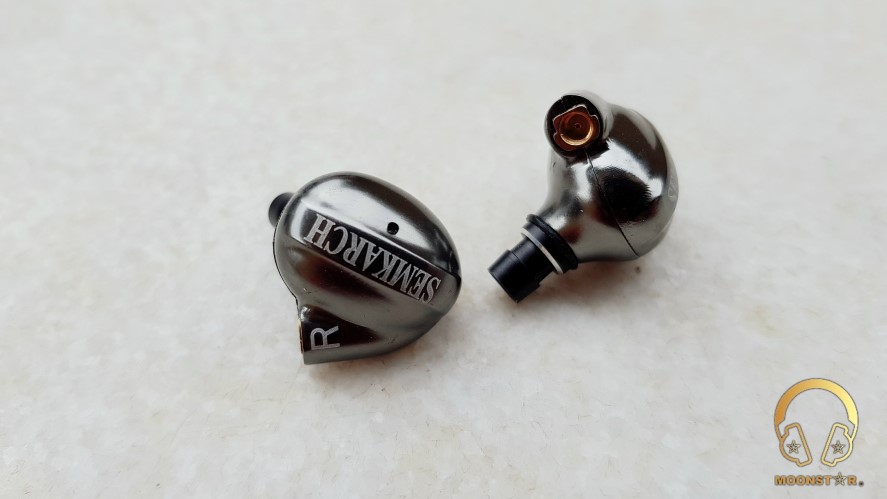
Disclaimer:
I would like to thank Semkarch for providing me this sample via Penon Audio for review purposes. I am not affiliated with Semkarch and Penon Audio beyond this review and these words reflect my true and unaltered opinions about the product.
Price:
The Semkarch SKC-CNT1 is available on Penon Audio for 95,00 USD.
Purchase Link: https://penonaudio.com/semkarch-skc-cnt1.html
Package and Accessories:
The Semkarch CNT1 comes in a black cardboard box with a textured surface, which sports the brand name SEMKARCH®.
This box is including the following contents/accessories;
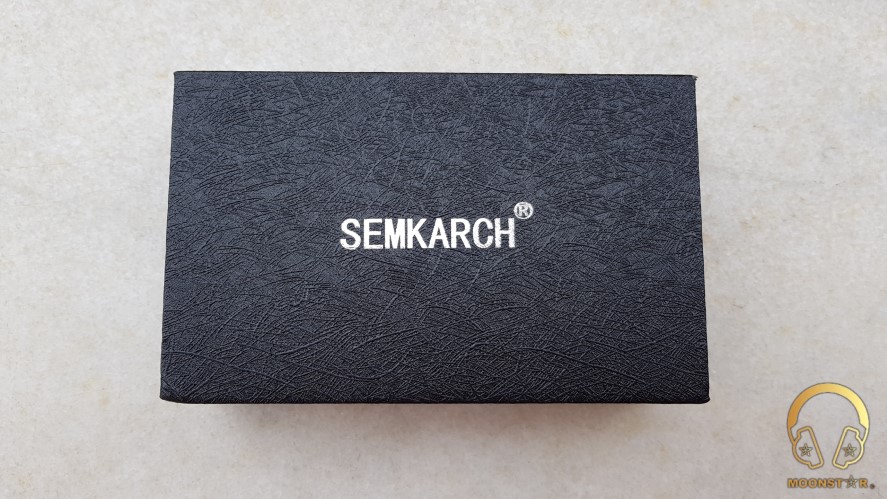
The Semkarch CNT1 comes with four (4) pairs of silicone eartips that have a pretty similar look like some regular Sony eartips. This eartips are one of my favorites due the use of a very comfortable to wear/insert soft silicone material.
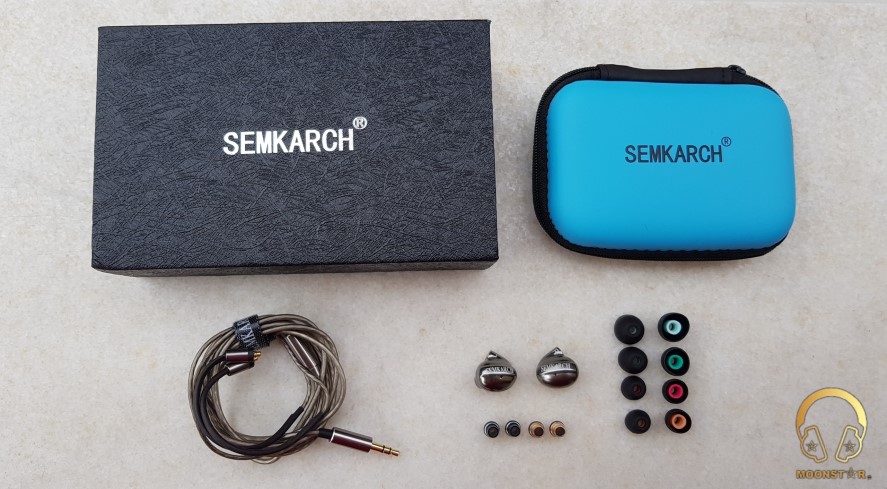
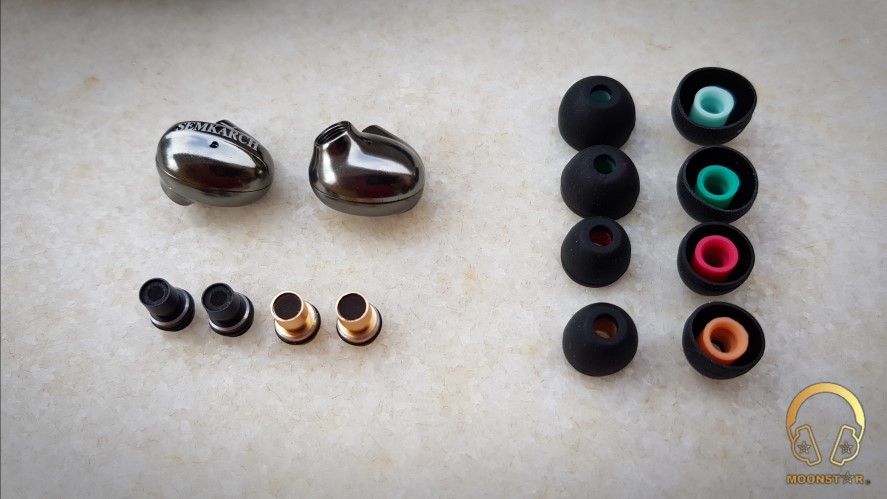
The carry case with zipper is in turquoise color and is ideal in size to put in the monitors+cable and all included accessories.
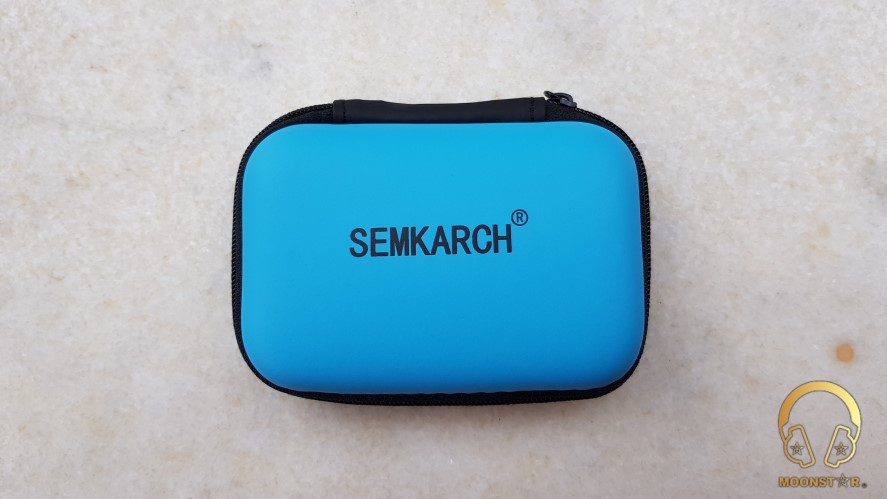
Design, Fit and Build Quality:
The housing of the Semkarch CNT1 monitor is made of metal and has a pretty solid to look and feel. The all metal housing of has a mirror like silver finish and has a rounded walnut like shape. The fit and ergonomics of the monitor is pretty good with its medium sized housing.

The housing is made of two parts the backs which are the back and front panel.
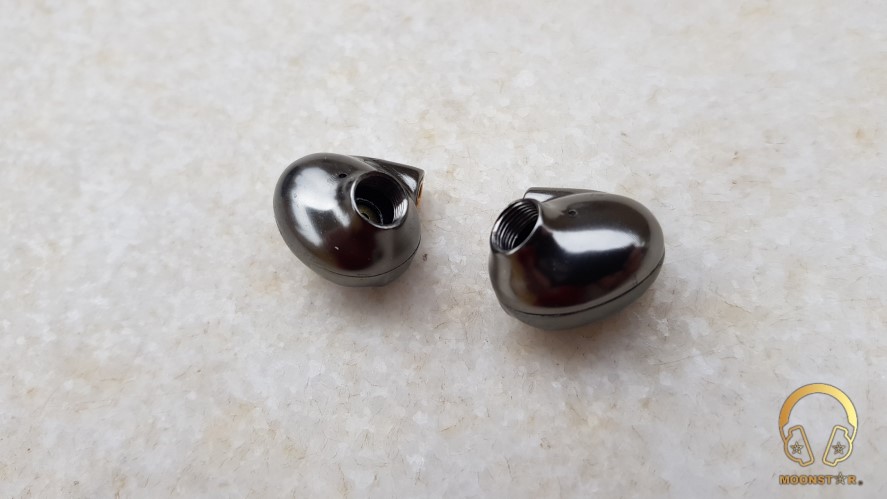
On front of the housing are the Left (L) and Right (R) markings, one vent and the brand logo, which is printed in white color.
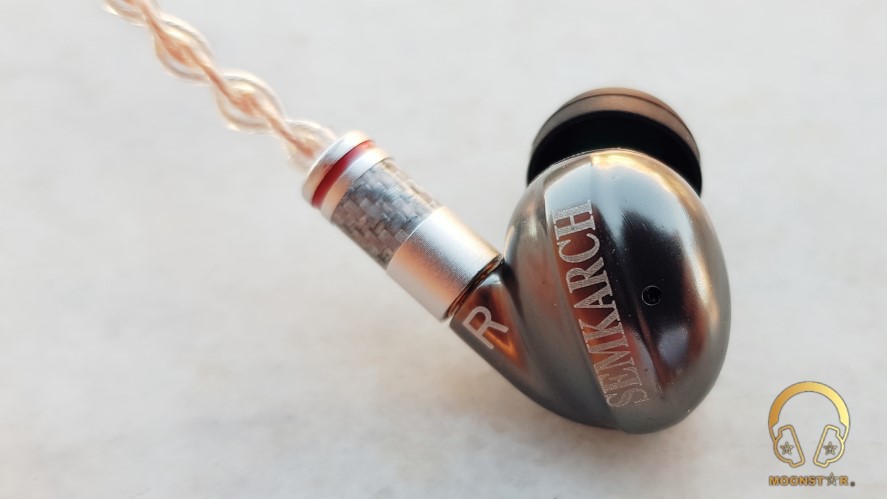
On the back are a second vent and the female nozzle insertion for the sound tuning nozzle filter, which has a 45 degree angled profile.
They are two (2) sound tuning filters, one in gold and one in black.
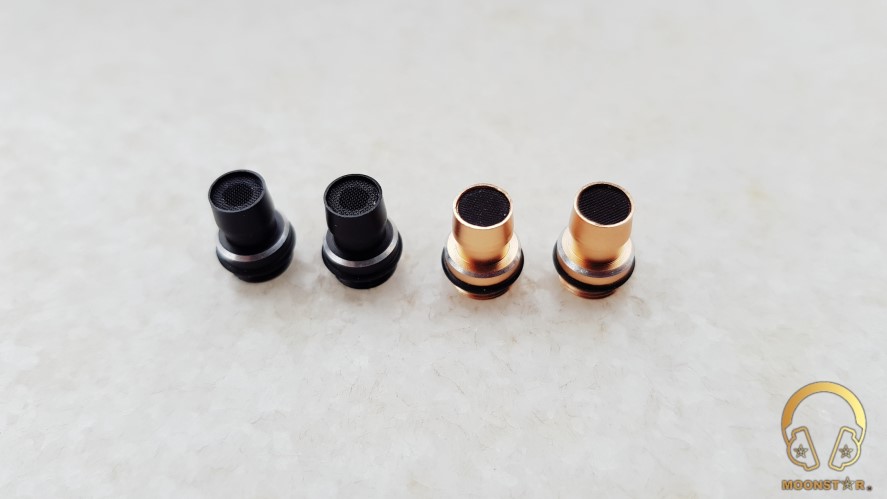
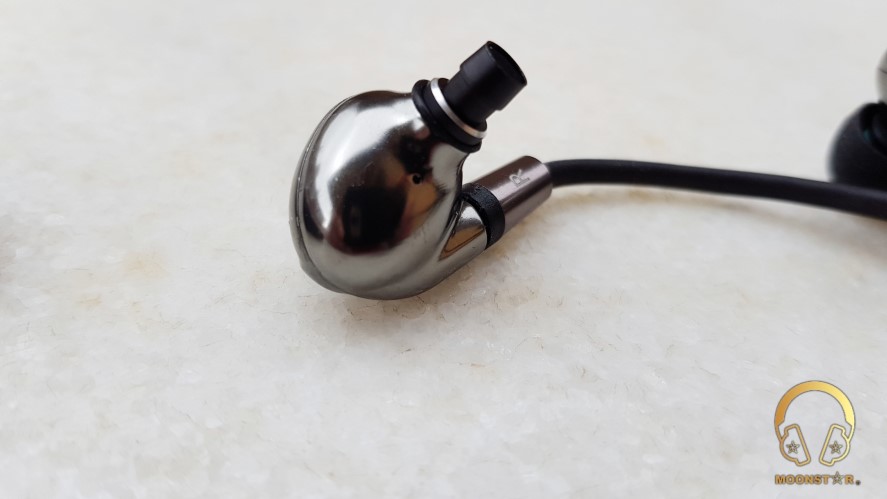
The Semkarch CNT1 comes with a detachable cable with MMCX (Micro Miniature Coaxial) connector, which has a 2 core wire design with a unknown type of copper material/purity. The cable material is coated with a grey semi transparent TPU material. The microphonic effect for this cable is on an acceptable level.
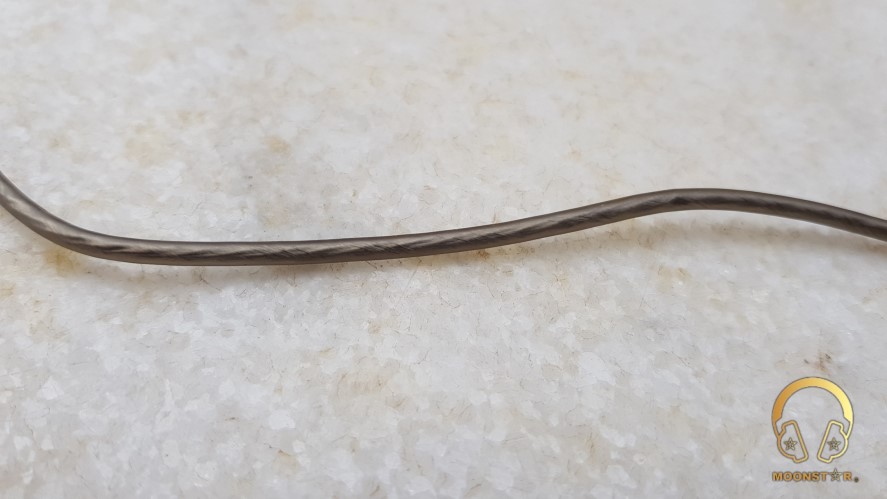
The housing of the MMCX connectors is made of metal and has a gun metal colored finish with Left and R markings.
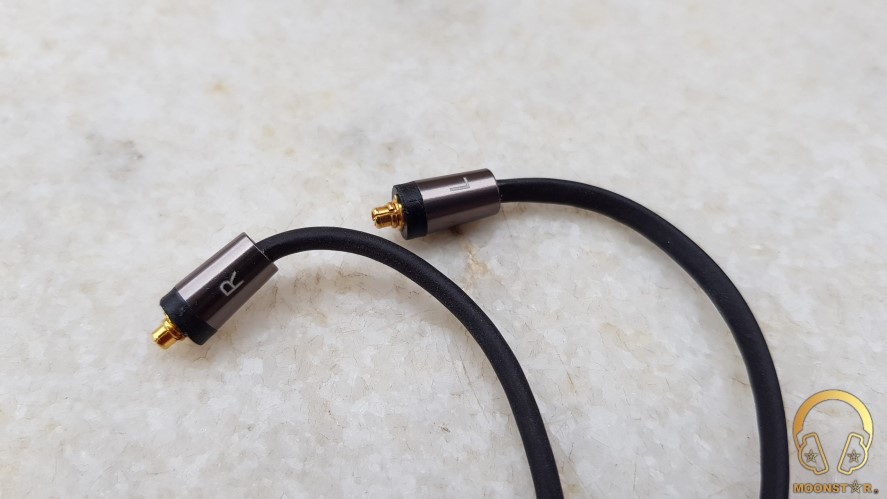
The cable sports shrink tube plastic ear guides, which is pretty elastic and comfortable to wear over my ear.
The cable has a y splitter that sport the model description (SKC-CNT1) and a chin slider, which are all made of metal.
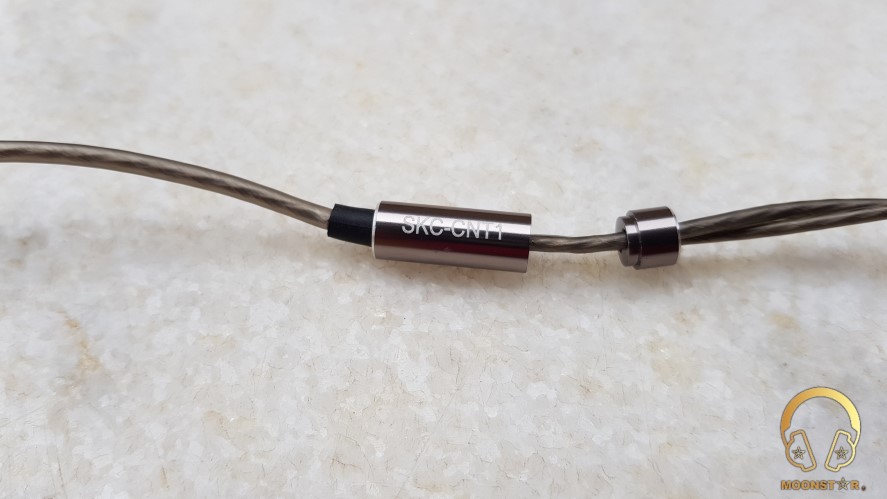
The cable has a straight profiled plug with the same gunmetal color metal housing that sports the brand name. The headphone jack is gold plated and has a 3 pole unbalanced jack.
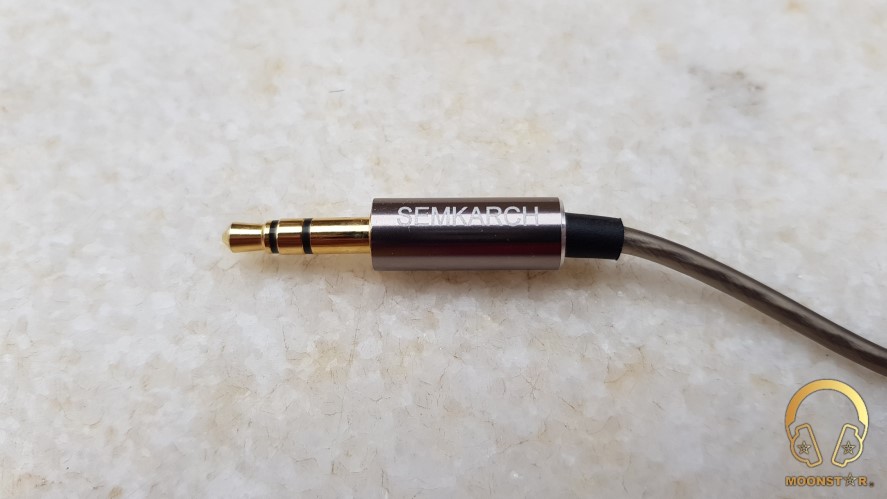
The Semkarch CNT1 has an above average isolation, which is slightly lower compared to In-Ear Monitors with a semi custom universal shell.
Technical Specifications:
Equipment’s used for this review:
IEM’s : Semkarch SKC-CNT1, iBasso IT01, Mee Audio Pinnacle P2
DAP&DAC’s : Cayin N5II, Fiio M7, Hifiman Super Mini, xDuoo XD10 Poke, Audirect Beam
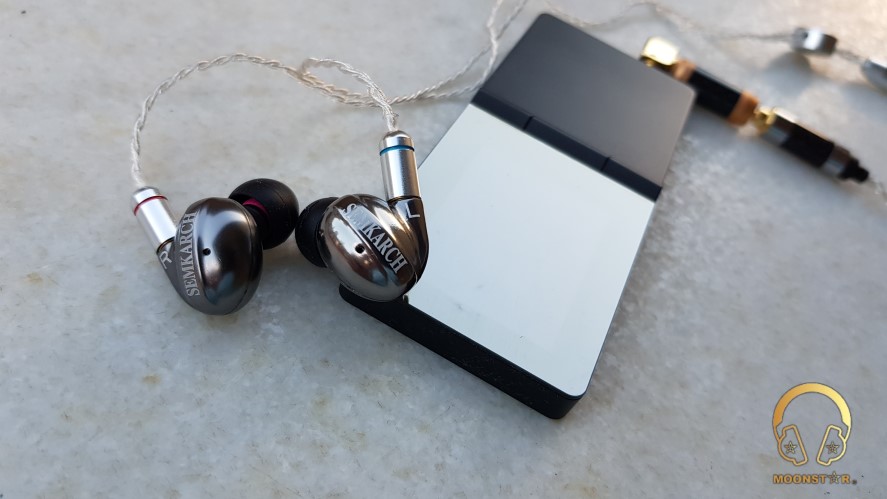
Albums & tracks used for this review:
The Sound:
This review is written after a burn-in process of around 90-100 hours and I have used the stock silicone ear tips which are included to the box.
Sound Signature:
The Semkarch CNT1 has a entertaining sound signature with its great bass impact and relative musical presentation. The CNT1 has two sound tuning filters that especially affect the sound signature of the lower and upper frequency regions. The gold filter shows slightly less bass and more upper midrange and treble emphasis, while the black filter has more bass but less transparency in the midrange, together with it’s slightly warmer presentation.
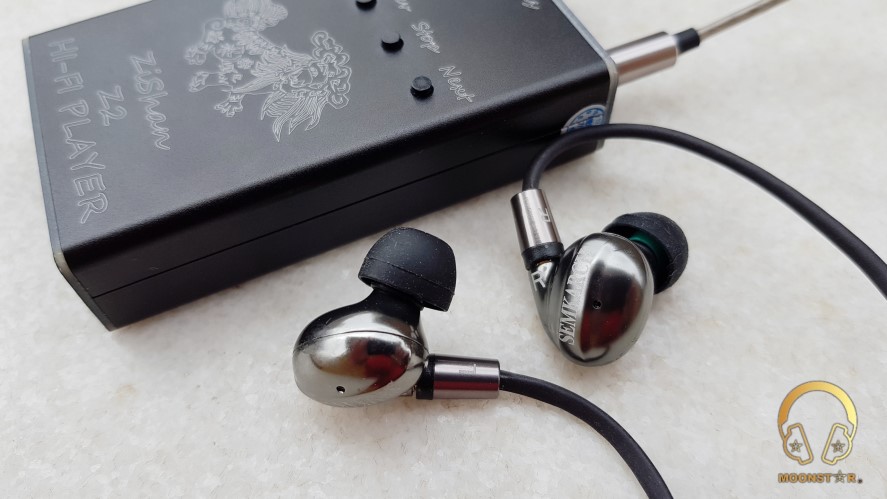
Bass:
One of the real highlights of the Semkarch CNT1 the bass response. The sub-bass presentation of the CNT1 with the black filter sounds fairly deep and has moderate extension, while the gold filter is adding additional control and to the sub-bass presentation. The quantity is good enough to satisfy bass lovers with genres, who needs good rumble like Trance, Edm or Pop music.
The mid-bass sounds full bodied and relative warm with the black filter, while the gold filter is slightly dropping the quantity, but adding slightly more extension. Both bass and electro guitars are sounding pretty musical for this price tag.
Midrange:
The midrange of the Semkarch CNT1 sounds a bit recessed due the V shaped tuning.
I personally come to the conclusion that the CNT1 performs better with male vocals than female voices. Because male vocals sounding warm and fuller due the relative thick tonality caused by the mid-bass emphasis. Female vocals sounding a tad warmer than neutral and there is missing some cleaners with the black filter, which can be improved by the use of the gold filter that is adding additional transparency to the overall midrange presentation.
When it comes to the instrument performance I can confirm that the CNT1 is pretty good in this regarding. Instruments with thicker notes like drums, guitars etc. sounding more delicious, than instruments like cymbals or flutes that need additional sparkle. This is a result of the upper-midrange tuning of the CNT1, which is missing some brightness and presence with the stock black filter. The gold filter is adding some refinement and slightly more sparkle to the upper midrange, but I would still prefer a bit more sparkle.
Treble:
The treble range of the Semkarch SKC CNT1 sounds smooth and calm, which can be descript as treble tuning for easy listening. The treble extension and the detail level of the CNT1 are on a moderate level.
It is not very bright and vivid like the most V shaped In-Ear Monitors on the market, but the treble quality and quantity is good enough to listen to modern music genres like pop, rock, edm and even some acoustic music’s.
The sparkle and sharpness is a bit on the limit with genres like metal music or classical music, but the gold filter is improving the overall sparkle and brightness slightly and is adding extension.
One of the most remarkable abilities of the Semkarch CNT1 in treble region is the control ability and the soft/relaxing presentation, which makes long music listening periods possible, without to sound too lifeless or veiled.
Soundstage:
The soundstage performance of the Semkarch SKC CNT1 is on an average level. The soundstage is slightly wider than its depth, with a moderate level of instrument separation, which quite ok for this price point.
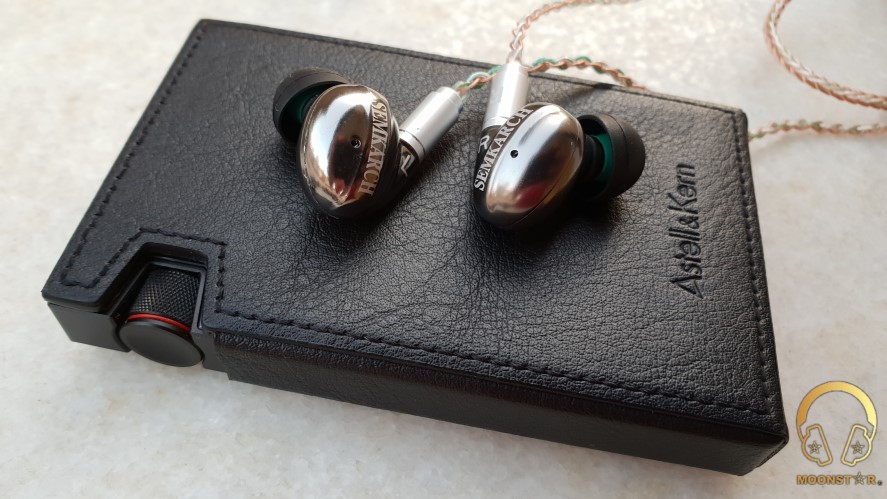
Comparisons:
Semkarch SKC CNT1 vs Mee Audio Pinnacle P2
Both IEM’s have sharing the same popular V shaped sound signature but with different tonality.
The Pinnacle P2 has slightly more sub-bass rumble and depth, but has less control than compared to the Semkarch CNT1. Both IEM’s sharing some great bass impact especially in the mid-bass region, which gives a nice body to the overall presentation. The main difference is the control in this area, where the CNT1 is superior to the Pinnacle P2.
The midrange of the Pinnacle P2 and CNT1 sounds a bit recessed due the V shaped sound signature. The CNT1 sounds slightly cleaner and transparent in the midrange compared to the veiled presentation of the Pinnacle P2, which is caused by the mid-bass hump and some control problems in this area. Male vocals sounding thick and full bodied on both IEM’s, but the Semkarch CNT1 is a bit more successful while listening to female vocals with the gold filter.
The treble range of the Semkarch CNT1 is slightly brighter and has more sparkle than those of the Pinnacle P2, especially with the gold filter, which improves the treble response of the CNT1. The treble of the CNT1 has a ticker tonality with slightly better extension (gold filter) and control. The detail rendering of both In-Ear Monitors is pretty equal, maybe a little bit better with the CNT1, when you use the gold filter.
When it comes to soundstage presentation performance, the first noticeable difference is the depth where the CNT1 performs better, while the Pinnacle P2 performs slightly better in wideness. The Semkarch CNT1 is a little bit more precise in terms of instrument placement.
Semkarch SKC CNT1 vs iBasso IT01
Both IEM’s have V shaped entertaining sound signature.
The iBasso IT01 has slightly less sub-bass quantity and nearly equal mid-bass emphasis compared to the Semkarch SKC CNT1. The sub-bass of the CNT1 goes deeper, sounds fuller and has additional rumble, while the control IT01 has little bit better control.
The mid-bass quantity and control are nearly identical, maybe slightly more/better with the CNT1 if you use the black filter, while the IT01 has the upper hand regarding to speed.
The midrange of the IT01 sounds more transparent, bright and with additional sparkle, while the CNT1 has a smoother/softer presentation, which is ideal for long listening periods.
When it comes to the vocal comparison, the CNT1 is fuller and pleasant with male vocals, while the IT01 sounds more realistic and lifelike with female vocals due a slightly boost in the upper midrange are. The iBasso IT01 excel’s slightly better in terms of overall detail and instrument presentation while the difference is pretty small.
The iBasso IT01 sounds brighter, has a slightly better treble extension and shows more sparkle than those of the Semkarch CNT1, which has a slightly rolled-off top end. The benefit of this additional treble energy is more detail and rendering of air, while the Semkarch is more suitable for longer listening periods due the smoother/softer presentation.
The difference in soundstage performance of this IEM’s is pretty low. The iBasso IT01 has the slightly wider soundstage, while the difference for depth is less noticeable, maybe a tad better with the IT01. The iBasso IT01 is the more precise IEM in terms of instrument placement and definition.
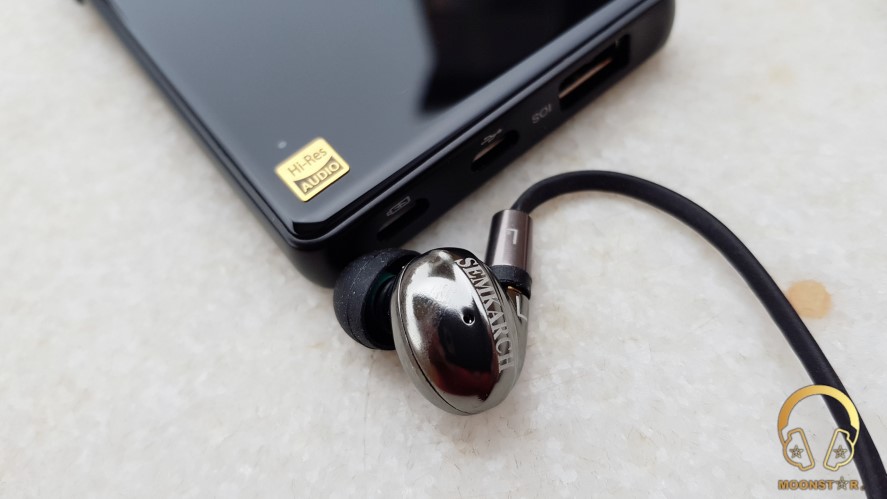
Conclusion:
The Semkarch SKC CNT1 is a fairly priced In-Ear Monitor with its great bass response, entertaining tuning and two sound tuning filters, which are helping to fine tune the overall sound signature. The built quality is pretty good, while the stock cable looks less impressive compared to the rest of the package.
Pros and Cons:
The IEM with an Entertaining Presentation
About Semkarch and the SKC-CNT1:
Semkarch is a China based company, which is relative new in the world of audiophile equipments. The SKC-CNT1 is their first In-Ear Monitor on the market which has a single dynamic driver with two (2) sound tuning filter options.

Disclaimer:
I would like to thank Semkarch for providing me this sample via Penon Audio for review purposes. I am not affiliated with Semkarch and Penon Audio beyond this review and these words reflect my true and unaltered opinions about the product.
Price:
The Semkarch SKC-CNT1 is available on Penon Audio for 95,00 USD.
Purchase Link: https://penonaudio.com/semkarch-skc-cnt1.html
Package and Accessories:
The Semkarch CNT1 comes in a black cardboard box with a textured surface, which sports the brand name SEMKARCH®.
This box is including the following contents/accessories;
- 1 pcs x Semkarch SKC-CNT1 In-Ear Monitor
- 1 pcs x Detachable Cable with MMCX connectors
- 4 pairs x Silicone eartips
- 2 pair x Sound tuning filters (Gold&Black)
- 1 pcs x Carry Case

The Semkarch CNT1 comes with four (4) pairs of silicone eartips that have a pretty similar look like some regular Sony eartips. This eartips are one of my favorites due the use of a very comfortable to wear/insert soft silicone material.


The carry case with zipper is in turquoise color and is ideal in size to put in the monitors+cable and all included accessories.

Design, Fit and Build Quality:
The housing of the Semkarch CNT1 monitor is made of metal and has a pretty solid to look and feel. The all metal housing of has a mirror like silver finish and has a rounded walnut like shape. The fit and ergonomics of the monitor is pretty good with its medium sized housing.

The housing is made of two parts the backs which are the back and front panel.

On front of the housing are the Left (L) and Right (R) markings, one vent and the brand logo, which is printed in white color.

On the back are a second vent and the female nozzle insertion for the sound tuning nozzle filter, which has a 45 degree angled profile.
They are two (2) sound tuning filters, one in gold and one in black.


The Semkarch CNT1 comes with a detachable cable with MMCX (Micro Miniature Coaxial) connector, which has a 2 core wire design with a unknown type of copper material/purity. The cable material is coated with a grey semi transparent TPU material. The microphonic effect for this cable is on an acceptable level.

The housing of the MMCX connectors is made of metal and has a gun metal colored finish with Left and R markings.

The cable sports shrink tube plastic ear guides, which is pretty elastic and comfortable to wear over my ear.
The cable has a y splitter that sport the model description (SKC-CNT1) and a chin slider, which are all made of metal.

The cable has a straight profiled plug with the same gunmetal color metal housing that sports the brand name. The headphone jack is gold plated and has a 3 pole unbalanced jack.

The Semkarch CNT1 has an above average isolation, which is slightly lower compared to In-Ear Monitors with a semi custom universal shell.
Technical Specifications:
- Driver : CNT (Carbon Nano Tube) Dynamic driver
- Sensitivity : 108±1 dB
- Impedance :32ohm
- Freq. range : 10Hz-26000Hz
- THD : <0.2%
- Rated power : 5mW
- Plug : 3.5mm gold-plated
- Cable length : 120cm
- Black filters : 3khz-10khz +2db
- Gold filters : 3khz-10khz -2db
Equipment’s used for this review:
IEM’s : Semkarch SKC-CNT1, iBasso IT01, Mee Audio Pinnacle P2
DAP&DAC’s : Cayin N5II, Fiio M7, Hifiman Super Mini, xDuoo XD10 Poke, Audirect Beam

Albums & tracks used for this review:
- Liquid Tension Experiment 2 – Acid Rain (Spotify)
- Opeth – Damnation (Tidal Hi-Fi)
- Metallica – Sad but True (Flac 24bit/96kHz)
- London Grammar – Interlud (Live) (Flac 24bit/44kHz)
- Laura Pergolizzi – Lost On You “Live at Harvard and Stone” (Tidal Hi-Fi)
- JehanBarbur – Yollar (Spotify)
- Minor Empire – Bulbulum Altin Kafeste (Spotify)
- Adam Taylor – Colour to the Moon (Flac 16bit/44kHz)
- Casey Abrams – Robot Lover (Tidal Hi-Fi)
- Vivaldi – Le QuarttroStagioni “The Four Season” (Tidal Hi-Fi)
- Steve Srauss – Mr. Bones (Flac 16bit/44kHz)
- Otto Liebert& Luna Negra – The River (DSF) – Binaural Recording
- Future Heroes – Another World (Tidal Hi-fi)
- Lorde – Team (Flac 24bit/48kHz)
- Tom Player – Resonance Theory “Album” (Tidal Hi-Fi)
The Sound:
This review is written after a burn-in process of around 90-100 hours and I have used the stock silicone ear tips which are included to the box.
Sound Signature:
The Semkarch CNT1 has a entertaining sound signature with its great bass impact and relative musical presentation. The CNT1 has two sound tuning filters that especially affect the sound signature of the lower and upper frequency regions. The gold filter shows slightly less bass and more upper midrange and treble emphasis, while the black filter has more bass but less transparency in the midrange, together with it’s slightly warmer presentation.

Bass:
One of the real highlights of the Semkarch CNT1 the bass response. The sub-bass presentation of the CNT1 with the black filter sounds fairly deep and has moderate extension, while the gold filter is adding additional control and to the sub-bass presentation. The quantity is good enough to satisfy bass lovers with genres, who needs good rumble like Trance, Edm or Pop music.
The mid-bass sounds full bodied and relative warm with the black filter, while the gold filter is slightly dropping the quantity, but adding slightly more extension. Both bass and electro guitars are sounding pretty musical for this price tag.
Midrange:
The midrange of the Semkarch CNT1 sounds a bit recessed due the V shaped tuning.
I personally come to the conclusion that the CNT1 performs better with male vocals than female voices. Because male vocals sounding warm and fuller due the relative thick tonality caused by the mid-bass emphasis. Female vocals sounding a tad warmer than neutral and there is missing some cleaners with the black filter, which can be improved by the use of the gold filter that is adding additional transparency to the overall midrange presentation.
When it comes to the instrument performance I can confirm that the CNT1 is pretty good in this regarding. Instruments with thicker notes like drums, guitars etc. sounding more delicious, than instruments like cymbals or flutes that need additional sparkle. This is a result of the upper-midrange tuning of the CNT1, which is missing some brightness and presence with the stock black filter. The gold filter is adding some refinement and slightly more sparkle to the upper midrange, but I would still prefer a bit more sparkle.
Treble:
The treble range of the Semkarch SKC CNT1 sounds smooth and calm, which can be descript as treble tuning for easy listening. The treble extension and the detail level of the CNT1 are on a moderate level.
It is not very bright and vivid like the most V shaped In-Ear Monitors on the market, but the treble quality and quantity is good enough to listen to modern music genres like pop, rock, edm and even some acoustic music’s.
The sparkle and sharpness is a bit on the limit with genres like metal music or classical music, but the gold filter is improving the overall sparkle and brightness slightly and is adding extension.
One of the most remarkable abilities of the Semkarch CNT1 in treble region is the control ability and the soft/relaxing presentation, which makes long music listening periods possible, without to sound too lifeless or veiled.
Soundstage:
The soundstage performance of the Semkarch SKC CNT1 is on an average level. The soundstage is slightly wider than its depth, with a moderate level of instrument separation, which quite ok for this price point.

Comparisons:
Semkarch SKC CNT1 vs Mee Audio Pinnacle P2
Both IEM’s have sharing the same popular V shaped sound signature but with different tonality.
The Pinnacle P2 has slightly more sub-bass rumble and depth, but has less control than compared to the Semkarch CNT1. Both IEM’s sharing some great bass impact especially in the mid-bass region, which gives a nice body to the overall presentation. The main difference is the control in this area, where the CNT1 is superior to the Pinnacle P2.
The midrange of the Pinnacle P2 and CNT1 sounds a bit recessed due the V shaped sound signature. The CNT1 sounds slightly cleaner and transparent in the midrange compared to the veiled presentation of the Pinnacle P2, which is caused by the mid-bass hump and some control problems in this area. Male vocals sounding thick and full bodied on both IEM’s, but the Semkarch CNT1 is a bit more successful while listening to female vocals with the gold filter.
The treble range of the Semkarch CNT1 is slightly brighter and has more sparkle than those of the Pinnacle P2, especially with the gold filter, which improves the treble response of the CNT1. The treble of the CNT1 has a ticker tonality with slightly better extension (gold filter) and control. The detail rendering of both In-Ear Monitors is pretty equal, maybe a little bit better with the CNT1, when you use the gold filter.
When it comes to soundstage presentation performance, the first noticeable difference is the depth where the CNT1 performs better, while the Pinnacle P2 performs slightly better in wideness. The Semkarch CNT1 is a little bit more precise in terms of instrument placement.
Semkarch SKC CNT1 vs iBasso IT01
Both IEM’s have V shaped entertaining sound signature.
The iBasso IT01 has slightly less sub-bass quantity and nearly equal mid-bass emphasis compared to the Semkarch SKC CNT1. The sub-bass of the CNT1 goes deeper, sounds fuller and has additional rumble, while the control IT01 has little bit better control.
The mid-bass quantity and control are nearly identical, maybe slightly more/better with the CNT1 if you use the black filter, while the IT01 has the upper hand regarding to speed.
The midrange of the IT01 sounds more transparent, bright and with additional sparkle, while the CNT1 has a smoother/softer presentation, which is ideal for long listening periods.
When it comes to the vocal comparison, the CNT1 is fuller and pleasant with male vocals, while the IT01 sounds more realistic and lifelike with female vocals due a slightly boost in the upper midrange are. The iBasso IT01 excel’s slightly better in terms of overall detail and instrument presentation while the difference is pretty small.
The iBasso IT01 sounds brighter, has a slightly better treble extension and shows more sparkle than those of the Semkarch CNT1, which has a slightly rolled-off top end. The benefit of this additional treble energy is more detail and rendering of air, while the Semkarch is more suitable for longer listening periods due the smoother/softer presentation.
The difference in soundstage performance of this IEM’s is pretty low. The iBasso IT01 has the slightly wider soundstage, while the difference for depth is less noticeable, maybe a tad better with the IT01. The iBasso IT01 is the more precise IEM in terms of instrument placement and definition.

Conclusion:
The Semkarch SKC CNT1 is a fairly priced In-Ear Monitor with its great bass response, entertaining tuning and two sound tuning filters, which are helping to fine tune the overall sound signature. The built quality is pretty good, while the stock cable looks less impressive compared to the rest of the package.
Pros and Cons:
- + Solid Bass Response
- + Entertaining Sound Tuning
- + Good Build Quality
- + Fairly Priced
- - Cable is a bit stiff
- - Missing of some midrange transparency/clearness
- - Treble extension
Comments
There are no comments to display.

![HTB1uFh7dOMnBKNjSZFCq6x0KFXaV[1].jpg](https://cdn.head-fi.org/a/10120016_thumb.jpg)

Although I gotta caution u that the T800 is not really natural in tuning and is no longer in the range of the budget sub 50 bucks CHIFI. It is a mild V shaped signature with boosted bass and treble. The treble is in fact bright, so not the best option if u are treble sensitive unless u play with knowles dampers or eartips/cables.